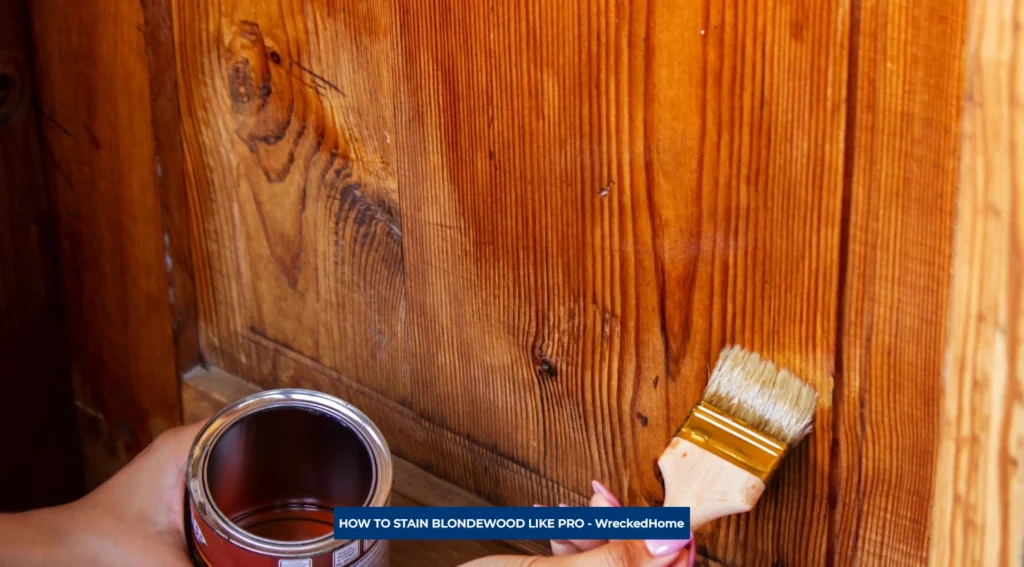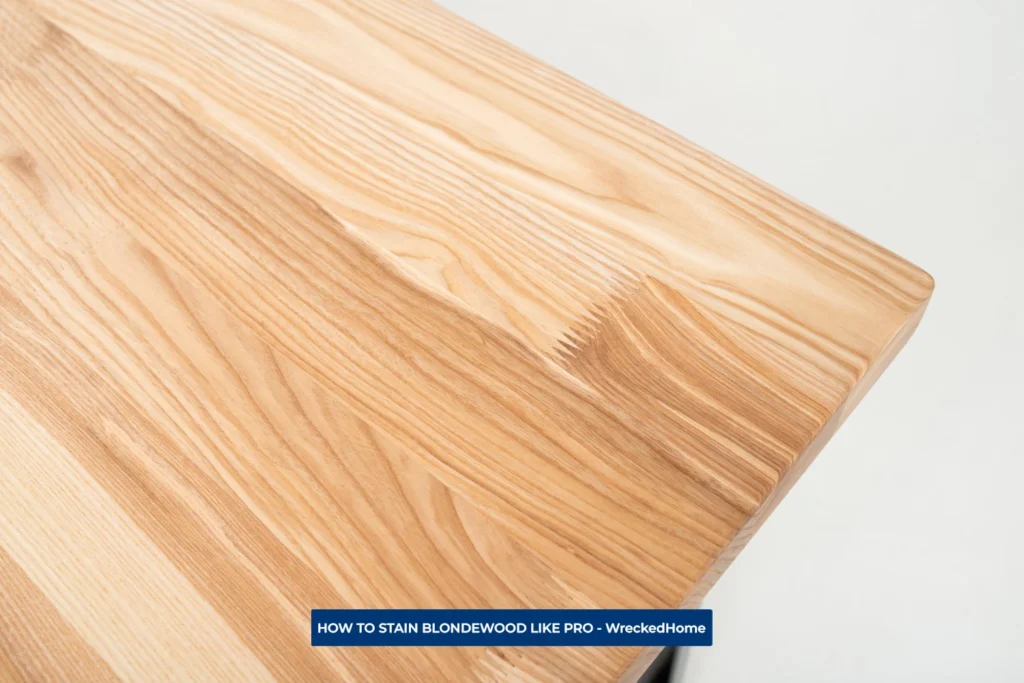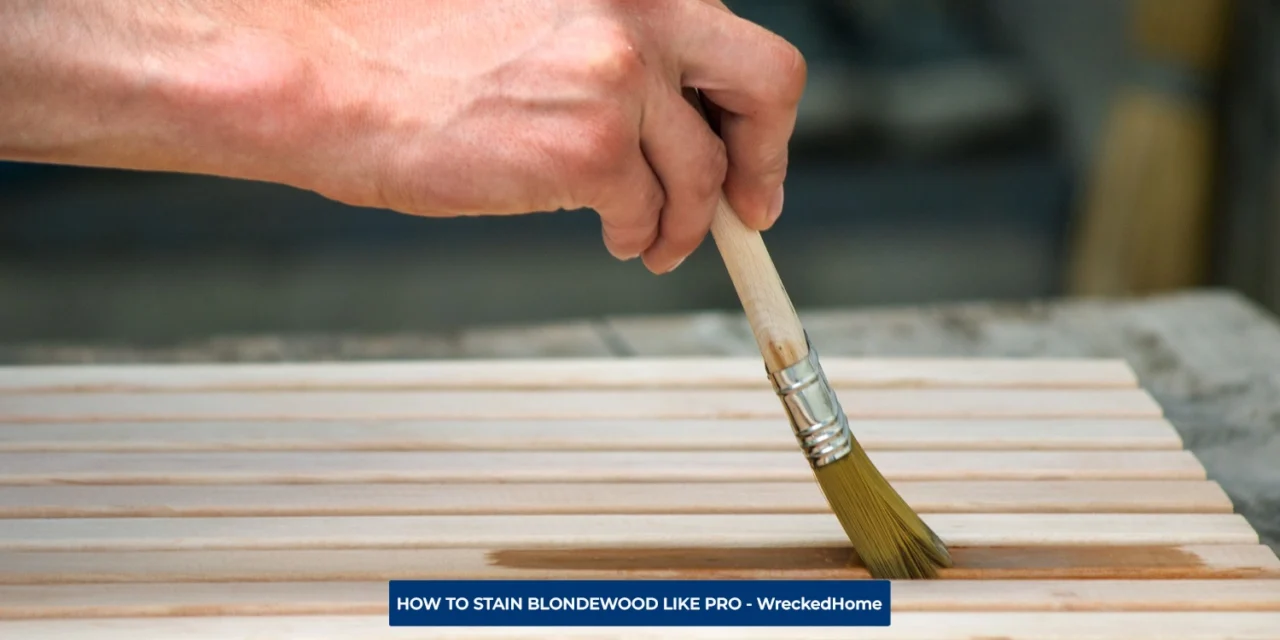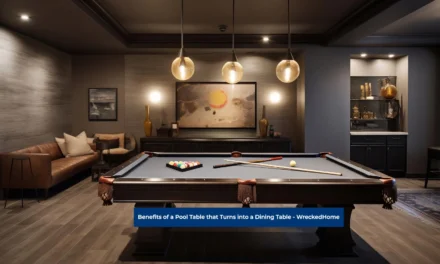Blondewood is a light color wood and many people love to use it for furniture making. Although blondewood is appealing, it can be better after staining. The process of staining blondewood is similar to staining wood but with little changes as blondewood is light in color.
Staining blondewood is possible in many ways like gel stains, brush-on stains, and spray stains by using stain sprayer. Which stain is best and how to stain blondewood are topics discussed in this article.
What Is Staining Blondewood?

The process of applying color liquid to wood is known as staining blondewood. Staining blonde wood is specifically used to enhance the natural beauty of wood and save it from damage. The liquid-applying color can be applied to raw and finished wood, but preparing the surface to apply the stain is first and foremost step.
Stain penetrates the wood fibers and changes the color without obscuring the grain. Blond wood for wood is available in light colors such as maple, oak, and ash. That’s why it is a popular choice for woodworking and furniture-making projects. Like brick staining, most people recommend staining blondwood due to its versatility and attractive appearance.
Why Stain Blondewood?
There are various reasons why people choose to stain blondewood and the most prominent ones are as follows:
- Stain the blondewood to increase the natural beauty of wood. Staining prominent grain of blondewood gives the wood rich and more luxurious appearance.
- Staining is used to achieve various colors including airy and light to dark and dramatic. This feature of staining blondewood helps match the existing decor or create a comfortable mood in a room.
- The staining can enhance the old piece of blondewood furniture and gives it a fresh and unique look.
- Staining blondewood protects the wood from moisture, UV rays and other damage. This staining method is really important for blondewood which is more susceptible to damage.
- Custom looks are easy to create with staining blondewood for furniture and other woodworking projects. Combine different colors and finishes and achieve your desired results.
- Staining can protect outdoor furniture from external elements and make it useful for a long time.
- If you have other woods in your home, such as dark hardwood floors, staining blondewood furniture can help to create a more cohesive and attractive look.
- Staining wood can increase the value of furniture and other wood-related projects. Stained wood becomes durable and attractive and is of higher quality than unfinished wood. It can withstand worse conditions and wear and tear than unfinished wood. This quality of stained blondewood makes it a perfect choice for high-traffic areas and frequently used furniture.
- A well-stained piece of blondewood furniture can be a beautiful focal point in any room.
- Staining blondewood changes the wood color and makes it less appealing for termites. Some stains contain chemicals that also repel termites. However, necessary steps should be taken to keep termites away from your home.
Types Of Wood Stains

There are three main types of wood stains. Let’s discuss wood stain types in detail.
- Oil-based
- Water-based
- Gel
Oil-Based Wood Stain:
Oil-based wood stains are water-resistant and durable. These stains are difficult to apply and need a long drying time. Due to the above qualities and more pungent smell than water-based stains, oil-based stains are a good choice for outdoor projects and furniture.
Water-Based Wood Stains:
Water-based wood stain is easy to apply and dry more quickly than oil-based stains. This particular stain has a milder smell but is less durable and water resistant. Therefore, water-based wood stains are suitable for indoor projects and furniture with less exposure to elements.
Gel Wood Stain
Gel wood stain is thick but easy to apply, but is difficult to remove if there is a mistake. The gel stains are a good choice for vertical surfaces such as doors and cabinets because they don’t drip. Gel wood stain is a little bit more expensive than other stain types.
Choosing blondewood stain depends on project needs and specifications, but water-based stain is best choice because this stain is easy to apply and dries quickly.
Choosing The Right Wood Stain For Blondewood
Blondewood is a versatile choice for furniture and flooring. Staining blondewood helps in creating a unique variety of looks, from light to dark and diary to warm and inviting. Considering few things before choosing a wood stain for blondewood is important.
Type Of Wood
The first thing to consider is the type of wood before staining blondewood. In some cases, maple and birch are more porous and will absorb more stain than others which gives a dark color result. Therefore, before applying the stain to wood, test the stain on an undefined area first.
Color
Before staining blondewood, the second thing that matters a lot is color. If you want to enhance the natural wood color, you should choose a stain color that is similar to the original color. To give the wood a dramatic look choose darker or different color stains.
- A light and airy look is achieved using light colors, such as white, light grey, or light yellow.
- Choose warm colors such as golden oak, cherry, or honey to get warm and inviting look.
Finish:
Once you choose your stain color, you have to choose a topcoat. This will protect the wood. You can choose a glossy or satin, or matte finish.
Preparing Blondewood For Staining
Prepare the surface properly before staining blondewood. A clean surface ensures that the stain adheres evenly and provides perfect results. Here are some prominent steps to follow for staining blondewood:
Clean The Wood:
Remove dust, grease, or dirt from the wood surface before staining blondewood. Clean the wood surface with mild soap and a water solution with a Microfiber Towel. After cleaning, dry the wood thoroughly to proceed to the next step.
Sand The Wood
The second step is to sand the wood. Wood sanding creates a smooth surface for stain to adhere properly. You should start with a coarse grit sandpaper. This will be 100-120 grit. Then, you can finish with a fine grit sandpaper that is 180-220 grit.
Remove Sanding Dust
Wipe away the sanding dust from the surface of wood. Use a clean cloth to remove sanding dust.
Apply A Pre-Stain Conditioner
The next step is to apply a pre-stain conditioner, this conditioner is a clear liquid that evens out the porosity of the wood and improves absorption of stains. Apply conditioner according to user manual or manufacturer instructions. After applying, leave wood for 30 minutes to dry completely.
Once the pre-stain conditioner is dried you are ready to proceed toward the next step of staining blondewood.
Tips For Preparing Blondewood For Staining Blondewood
Let’s discuss some more tips that help prepare blondewood for staining:
- For staining a large surface area, test the stain on an undefined area first to check the color.
- The hardware of all types should be removed before starting the process of staining a piece of furniture.
- It is important to apply stain in coats and allow each coat to dry completely before applying next coat.
- Once satisfied with color, apply to finish clear coat to protect and enhance stain.
Apply The Blondewood Stain
Now, the blondewood is ready for staining. The following steps are helpful in applying the stain properly.
- Stir the stain thoroughly, as it will be helpful to ensure that the pigment is evenly distributed throughout stain.
- Make sure to apply thin coat of stain. Use a clean cloth or brush to apply the stain in direction of wood again.
- Take a clean cloth and remove excess stains from the surface of the wood. Allow the first coat of the stain to dry properly. Drying the stain typically takes 2 to 4 hours.
- Apply the second coat of stain, if desired. The second coat is usually applied for dark colors. This step can be skipped if the first coat color is enough.
- Dry the second coat completely to proceed toward the next step.
- Apply a clear finish such as polyurethane or varnish to protect wood and enhance the stain.
Tips For Applying Blondewood Stain
Here are some more professional and helpful tips for staining blondewood.
- Make sure to wipe excess stains immediately otherwise, they dry on surface, and become difficult to remove.
- Apply the second coat of stain, ensure to sand the wood lightly between coats to remove any raised wood grains.
- Dry the clear finish completely before using wood.
Protecting Stained Blondewood:
After staining blondewood, it is important to protect the finish with a clear topcoat. This coat will help protect wood from moisture, discoloration, and damage. There are different varieties of topcoats available such as
- Polyurethane
- Varnish
- Shellac
Each topcoat comes with advantages and disadvantages. Polyurethane is the most durable type of topcoat but it is very difficult to apply. Varnish is less durable but easy to apply, while Shellac is the easiest to apply among all but it is also less durable.
While choosing a clear topcoat, make sure to consider the wood type you have stained and the required finish. Use a clear polyurethane topcoat for blondewood because it will protect the wood and enhance the blondewood natural color. Follow some important instructions while applying the topcoat.
- Apply a thin coat of topcoat and allow each coat to dry thoroughly before the next step.
- The topcoat protects the blondewood from moisture, damage, and discoloration.
- Enjoy a unique and beautiful stained blondewood for many years.
Maintaining Stained Blondewood
It is necessary to maintain stained blondewood and here are some tips that are helpful in maintaining the stained blondewood.
- Use a damp cloth and mild soap solution to clean stained blondwood. Dry the wood with a clean cloth afterward.
- Avoid using harsh chemicals or abrasive cleaners on stained blondewood. Blondewood looks dull due to these chemicals.
- Always work in well-ventilated areas while staining blondewood. Wood stains contain harmful fumes, so to avoid inhaling these fumes work in well-ventilated areas.
- Don’t over apply the wood stain because it causes the wood to become blotchy.
- Wear protective gear and gloves to avoid contact with wood stains. Staining wood can irritate eyes and skin.
- Dry the wood stain thoroughly before applying a clear topcoat. A clear topcoat will make the finish durable and protective.
Conclusion
Staining blondewood is a great process to make blondewood more appealing. Staining is easy but needs attention in following the right process.
If you do not feel comfortable with staining your wood after this guide, please hire a professional. Find A Pro Near You Here!
Frequently Ask Questions
Can You Stain Plywood Blond?
Staining plywood blonde is possible and a popular choice for staining because of its light color and fine grain. It is important to sand plywood lightly before staining, it can remove any rough patches and open up its grain to make stain penetrate better.
Can You Add Stain On Top Of Stain?
It is possible to add stain on top of stain, but sanding the first coat of stain lightly before applying the second coat is necessary.





































